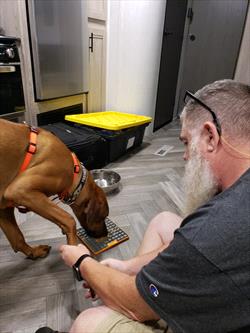When it comes to changing behavior, training alone is often not the answer. If your goal is to change behavior long-term, your pet will need behavior modification instead. Training focuses on specific behaviors like coming when called, sitting politely at the door, touching a target with their nose, and walking on a leash without pulling. Behavior modification involves changing behavioral and emotional responses and more specifically, how your pet feels and acts.
The Five Steps of Behavior Modification
Step One: Avoid all the things that cause the behavior. This may mean stopping all walks, placing your dog away in a “safe haven” before guests arrive, or letting toenails get a little long. While this seems counterproductive, the brain needs a vacation from all things scary to keep the behavior from worsening. During this break, medications may be needed, and new behaviors learned before the behavior modification process can even start.
Courtesy of Christine D. Calder, DVM, DACVB
Step Two: Open the lines of communication between you and your pet. Learn body language so you can understand how your dog or cat is feeling. Reduce anxiety by stopping all corrections or punishments since these methods probably are not working anyway. Instead of saying no or yelling at your pet, reinforce the behaviors you would rather see.
Courtesy of Christine D. Calder, DVM, DACVB
Step Three: Build a toolbox of known behaviors such as voluntary eye contact, touch, or a chin rest. These behaviors encourage your pet to “check in” more frequently and can redirect your pet to another activity. Substitute the unwanted behavior with an alternative, like sitting instead of jumping.
|
Step Three: Voluntary Eye Contact
Courtesy of Christine D. Calder, DVM, DACVB |
Step Three: Touch
Courtesy of Christine D. Calder, DVM, DACVB |
Step Four: Many pets with behavior problems have trouble settling and focusing. Teaching your pet how to relax is often key to changing behavior long term. Before exposing your pet to the environment or to things that trigger their behavior, they need to learn how to stay calm and keep their anxiety in check.
Courtesy of Christine D. Calder, DVM, DACVB
Step Five: Systematic Desensitization and Counter Conditioning (DS/CC) are used to change behavior long term. This is when triggers, including sounds, people, other animals, objects, and environments, are reintroduced to your pet gradually while controlling distractions and distance. Pair these triggers with good things, like food and play, to change how they feel and respond.
Courtesy of Christine D. Calder, DVM, DACVB
As you work through the steps above, remember that behavior modification will be a slow process with no quick fixes. If you have questions about your dog’s behavior, always contact your veterinarian.








